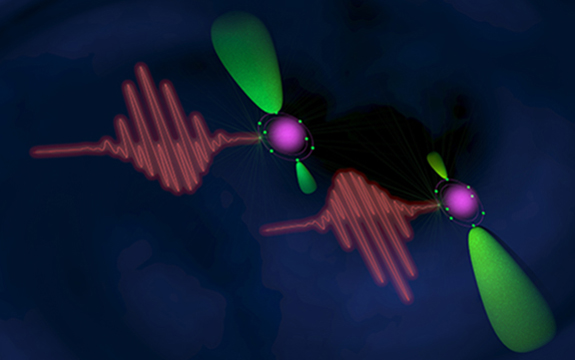Controlling ultrafast electrons in motion

In Summary
The fully coherent free electron laser, FERMI, paves the way to control ultrafast electron motion.
An international team of researchers has used the light produced by the FERMI free electron laser in Trieste, Italy to control the ultrafast movement of electrons.
The researchers used a beam of light of two wavelengths – two different colours – to control the direction of electrons ejected from an atom by the light on the scale of attoseconds – billionths of a billionth of a second.
The superfast scale of the experiment means it is now possible to study and control extremely fast processes, such as of the movement of electrons, between two types of elements in a chemical bond.
“Chemical, physical and biological processes are intrinsically dynamic, because they depend not only on the atomic and electronic structure of matter, but also on how they evolve in time, lead author and Adjunct Professor at Swinburne University of Technology, Kevin Prince, says.
“Atoms in a molecule move on the scale of femtoseconds – a few millionths of a billionth of a second. But electrons, which are the basis of chemical bonds, are much faster and in the processes they cause, they move a thousand times faster – on the scale of tens or hundreds of attoseconds.
“Like many in the scientific community we have been working for years to develop innovative analytical methods with attosecond resolution to study and control fast dynamics. With this work, that exploits the exceptional properties of the laser light from FERMI, we can say we have finally achieved our goal.”
The result was achieved by an international team from Italy (Elettra-Sincrotrone Trieste, the Politecnico of Milano, the IFN, IOM and ISM institutes of CNR and ENEA), Japan (Tohoku University), Russia (Lomonosov Moscow State University), USA (Drake University, Des Moines, Iowa), Germany (Technical University of Berlin, University of Freiburg, European XFEL, Hamburg, Max Planck Institute for Nuclear Physics, Heidelberg) and Australia.
“This result opens up new prospects for research on ultrafast processes and for attosecond physics in Italy, and also at the international level,” says Giuseppe Sansone who, with his group at the Politecnico of Milano, contributed to the planning and carrying out of the experiment.
“The next step will be to apply the technique we have demonstrated to the study of more complex processes which occur on the attosecond scale such as catalytic processes and atmospheric chemistry,” Professor Prince says.
The experiment, published in Nature Photonics, opens the way for scientists to study more complex processes that occur in nature on the scale of attoseconds, including photosynthesis, combustion, catalysis and atmospheric chemistry.
The FERMI laser facility is located at the research Centre Elettra Sincrotrone Trieste in Italy. Professor Prince has been an adjunct Professor at Swinburne University of Technology for many years with close collaboration with Professor Feng Wang at School of Science.

